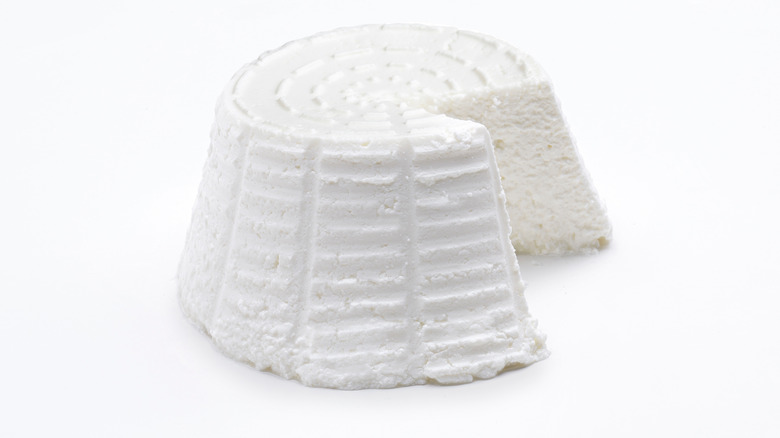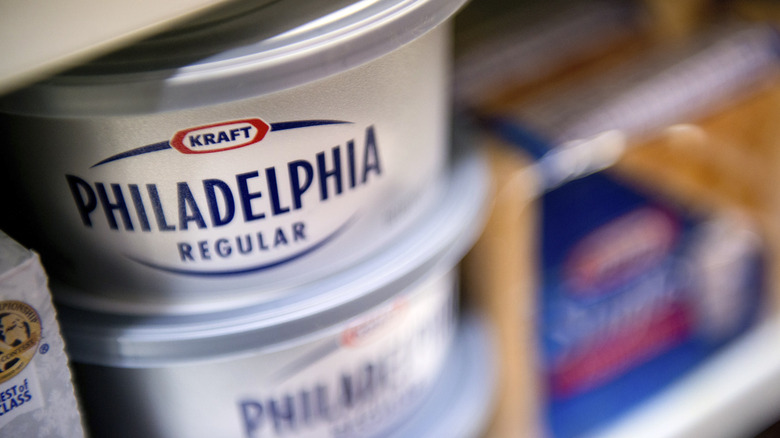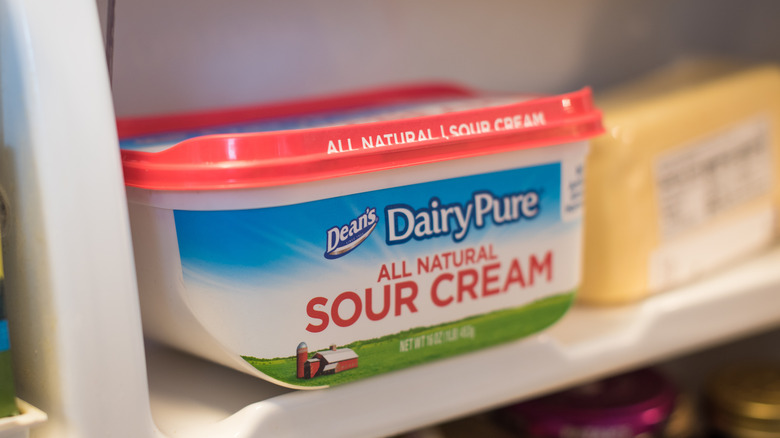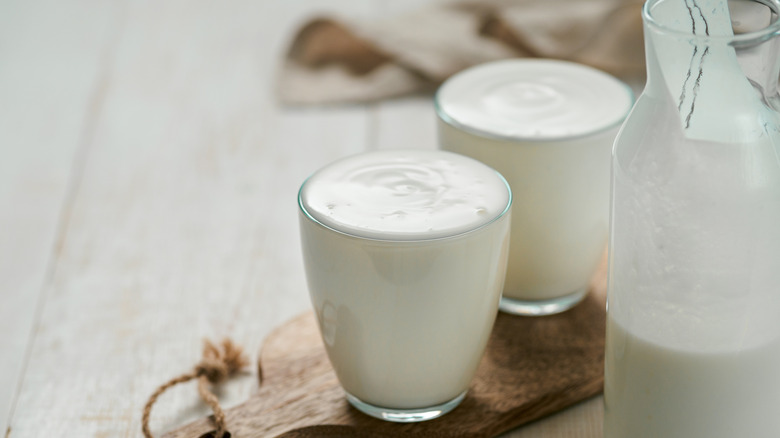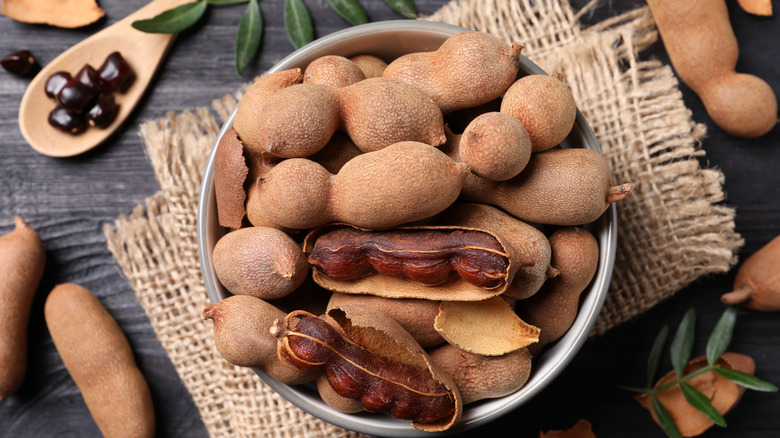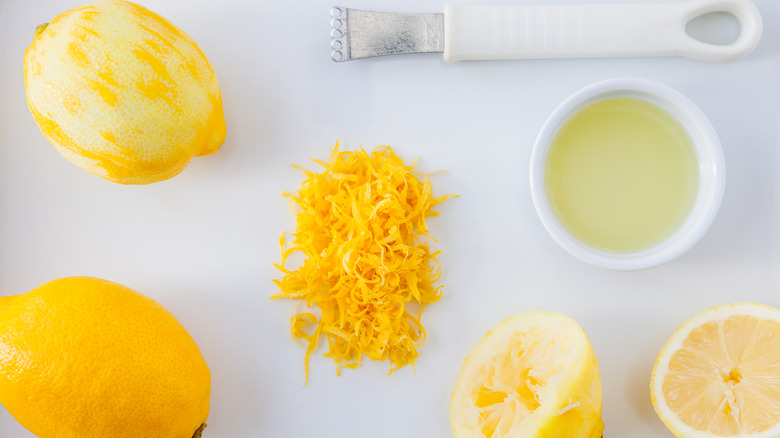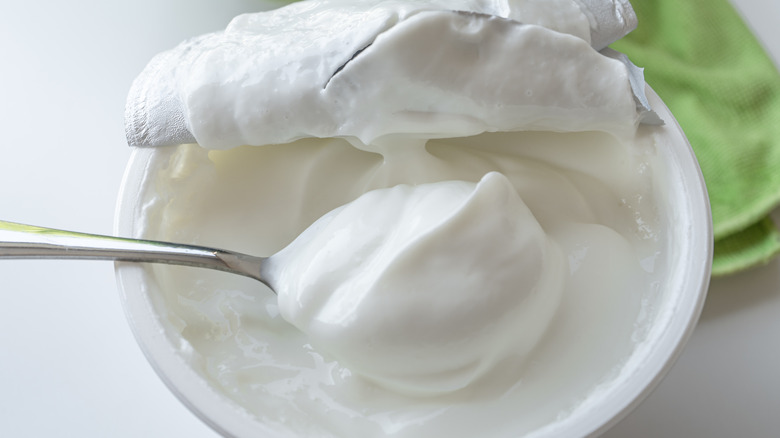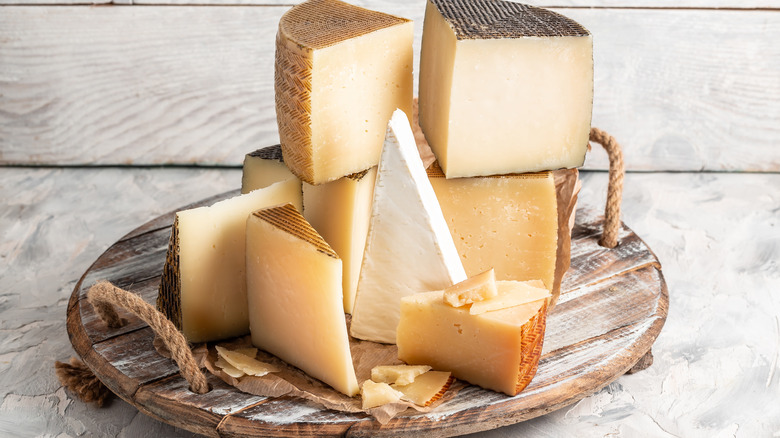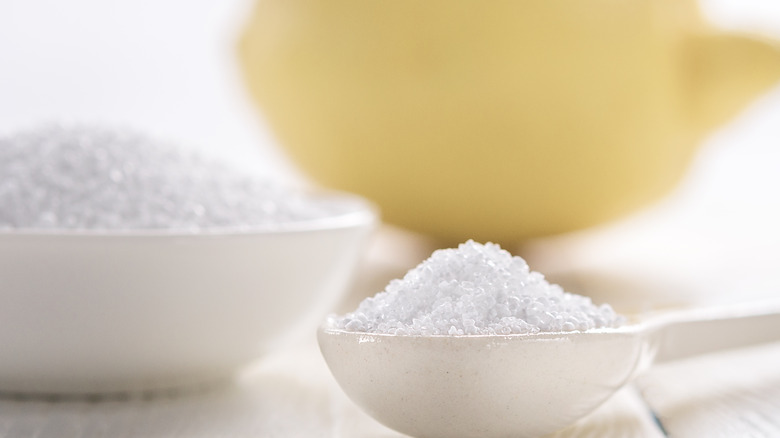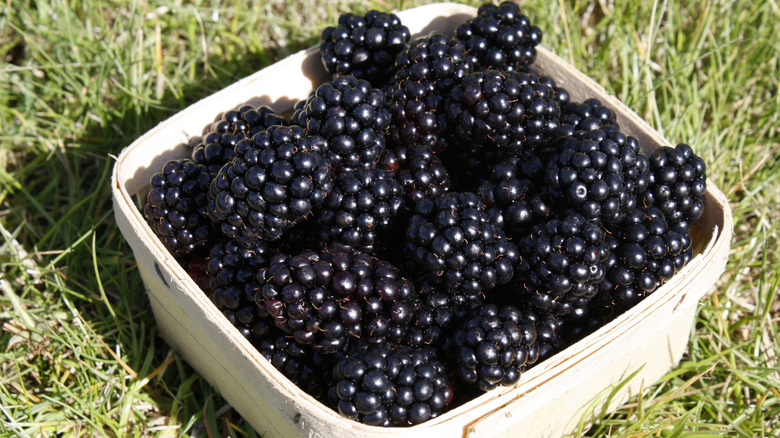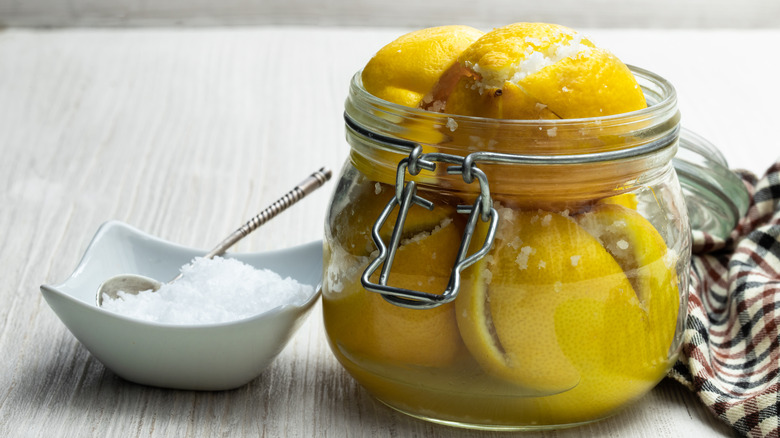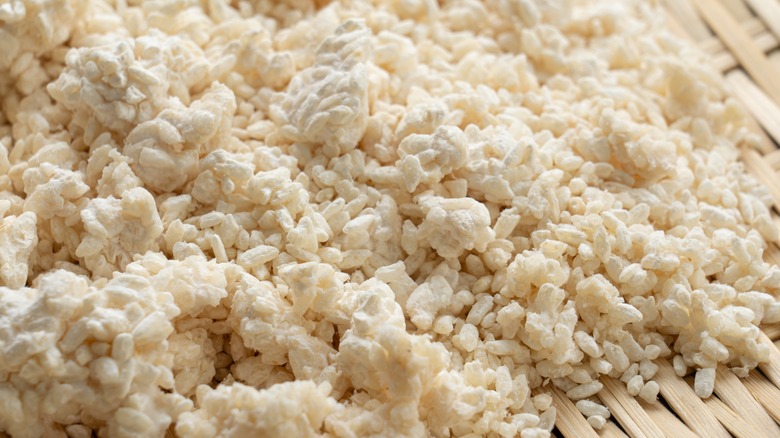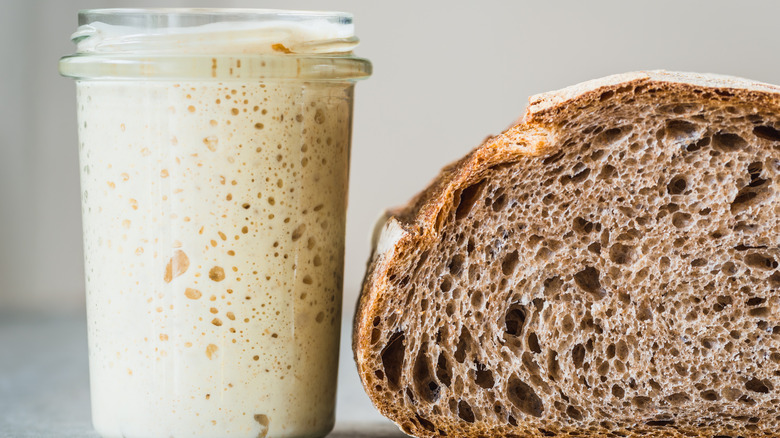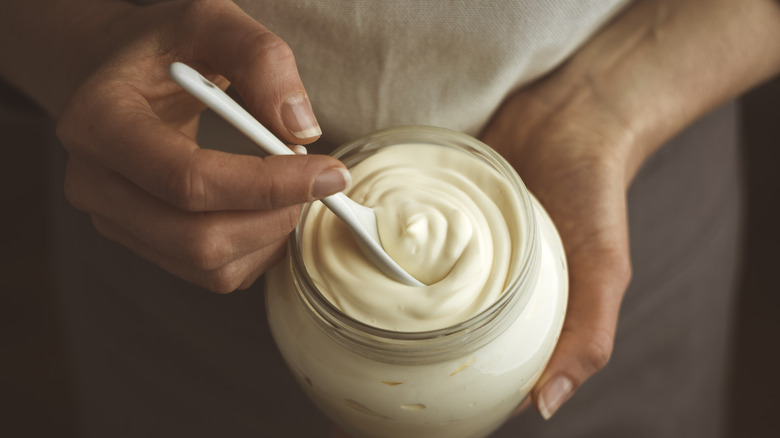15 Tangy Ingredients That Will Elevate Homemade Baked Goods
Home baking is something often done as a means of fulfilling several needs at once. In the cold and dreary days of winter, it can be a way to heat the house and create an inviting atmosphere while adding a bit of sweet or savory-flavored insulation to keep our bodies warm. Baking can be a way to share time with children, teach motor or math skills, or pass a few hours with a hands-on activity. It can be a form of generosity and love when shared with friends, guests, or family. Baking can also be a means of self-care or something to turn to when life or the news cycle gets to be too much.
One of the most incredible things about home baking, versus the professional variety, is the ability for low-risk play and experimentation in the kitchen. For those looking to up their home baking game, here are some excellent tangy ingredients to consider adding to your next kitchen adventure, guaranteed to yield significant, if not slightly surprising, results.
Ricotta
Not just for lasagna, you can use ricotta cheese in all kinds of ways, from pancakes to baked goods. Mild-mannered ricotta hails from Italy and is often paired with lemon to create a tangy and citrusy flavor that helps to balance out any sweetness and add a satisfyingly savory component.
Ricotta is not actually considered a cheese, but rather a dairy product and a byproduct of making other cheeses. In keeping with the foundation of Italy's waste-free culture when it comes to cooking, ricotta is made from whey leftover from the making of other cheeses, as the milk used to make the cheese will be heated until it naturally splits from the whey, leaving the whey to be cooked once more to create ricotta. Ricotta can be made from cow's and sheep's milk to produce slightly different-tasting products. Local preference will often be dictated by the region in Italy in which it is made.
While there are many outstanding artisan producers of ricotta, it is also a product that is easily made at home in just a few steps. It is a beautiful addition to baked cheesecakes and added to pancakes for a light and fluffy texture. It is traditionally used in various Italian and Sicilian sweet and savory dishes to add richness and depth of flavor.
Cream cheese
It's hard to come up with an instance where adding cream cheese wouldn't improve the results. From sauces to bagels to baked goods, this creamy, slightly tangy dairy product seems to improve everything it touches.
Originally brought to market by the still-famous brand Philadelphia, which incidentally was started by a dairyman from New York and not Philly, it has been improving dishes since it first became widely available in the late 1800s, (via Philadelphia Cream Cheese). By adding it to baked goods, not only will cream cheese increase the depth of flavor with its tanginess but using its brick form in baked goods can also add a softer texture to your crumb. You can substitute cream cheese for butter in all kinds of baking, even pie crusts, for richer results. Still, you will need to consider a few things, including temperature and fat content.
That said, you can find all the tang your heart desires without a need to substitute in our tiramisu cheesecake, which combines two of our favorite dairy-rich desserts into one spectacular result.
Crème fraîche
If one tangy dairy product were to rule them all, our money would be on the rich, tangy French-born "fresh cream" ingredient known as crème fraîche. Think of it as sour cream's older, slightly more subtle, bacterial-cultured cousin. Its naturally sour and somewhat nutty flavor, thick texture, and high-fat content (approximately 30%) make it an absolute dream to add to everything from taco fillings to tarts. Crème fraîche, a few tablespoons of sugar, and a drop of vanilla make the perfect topping for fruit pies or decadent chocolate cakes.
Are you struggling to find it in the dairy section of your grocery store? You can also make it at home with just a few ingredients: cultured buttermilk, heavy whipping cream, and citric acid. The acid works alongside a bit of time outside the refrigerator to help the mixture ferment, creating the slightly sour and tangy flavor that makes it a dream ingredient, even when eaten just by the spoonful.
Sour cream
What about a coffee cake that makes us love it so much? Several elements have us hooked, the first being that it allows for the perfect excuse to have cake for breakfast. Many of the coffee cakes we love most contain sour cream, an MVP of an ingredient that makes a coffee cake so exceptional. If you aren't adding sour cream to your coffee cakes, consider this the sign to start. Add it to the next thing you bake; it works a treat in many different kinds of baked goods for several reasons.
One of the things that make sour cream a must-have ingredient for baking is its ability to add moisture. Nothing is more disappointing than biting into a muffin or cake you've been looking forward to devouring only to discover it's dry and leaves you scrambling for water. Sour cream not only helps add moisture to your coffee cake but also creates a tender crumb and balances out sweet flavors with its tangy, savory properties, creating a perfectly balanced sweet treat.
Want to go all out? Add a dollop of sour cream to your next batch of freshly whipped cream, then top your freshly baked sour cream-enriched coffee cake with the stuff for the ultimate experience.
Buttermilk
Like ricotta, buttermilk is a dairy byproduct that makes our pancakes tastier, fried chicken more moist and tender, biscuits more satisfying, and sponge cakes much more moist and decadent. Buttermilk is made by culturing cows' milk, which thickens the texture and results in a tangy, slightly sour taste that makes the drink so distinctive.
There are so many ways to use buttermilk that we think it's worth keeping some on hand if you're a frequent baker. For those who love to drizzle caramel sauce onto a slice of cake, ice cream, or just your fingers, replace the suggested cream with buttermilk for an even richer taste with notes of tanginess that will send your tastebuds soaring. Added into a simple savory cornbread or sweet pound cake recipe for a moisture-assured tender crumb and rich flavor that will keep you headed back for more. You can also add buttermilk to savory bakes like a quiche to make for an even more decadent custard, bringing out the umami-rich flavors of the cheese or smoked meats, if using.
Tamarind
Tamarind is an incredible ingredient, used widely across India and the Caribbean for its natural sweet-and-sour flavors. It has been used for centuries for its medicinal properties by various cultures. It is known for being rich in antioxidants, polyphenols, and flavonoids which all have immune and health-boosting properties, (via BBC Good Food). It is often sold as pulp or paste in many Asian supermarkets. Depending on how it is purchased, an easy way to use it at home is by adding boiling water to loosen its consistency for sauces, dips, and curries or to create a drizzle to be poured over the cake. Tamarind pods can also be roasted or have their seeds ground and used within cakes.
Tamarind plays well with many ingredients, including ginger and dates. It is often paired with rich and creamy coconut milk to create an excellent balance that makes palates exceedingly happy. Nik Sharma's recipe for date and tamarind loaf, from his cookbook "Season: Big Flavors, Beautiful Food," comes complete with a tamarind glaze to coat the loaf spiced with black pepper and ginger. It has us firing up our ovens and running through the ingredients list to make sure we've got everything on hand.
Lemon
When life hands you lemons, use them in your next baking project. The origins of the lemon are unknown, but its use and prevalence in cooking are celebrated worldwide. Thought to be native to South Asia, the fruit likely traveled to the Mediterranean, then through Persia and into the Southern Levant, which is why the flavor is so heavily used within cuisines from these areas.
Not only are lemons bursting with bright, tart flavors, but did you know their juice can also help make better-baked goods? Adding just a teaspoon and a half of lemon juice, when paired with baking soda or powder, helps to activate the leavening agents, leaving your muffins bouncier and your cakes fluffier.
We suggest using fresh lemon juice when working with intensely sweet flavors like honey. The liquid will help to bring out fresh fruit flavors like apples or cherries, especially in a pie. We suggest lemon zest for a slightly more subtle, but still bright, lemony zing. You'll find many of these forms in these lemon bars, but you can incorporate separate elements into different doughs, crusts, cookies, and crumbles for great results.
Greek yogurt
Like lemon juice is reported to do, adding greek yogurt to a bake that uses baking soda or bicarb can help to supercharge its effect, leaving you with fluffier cakes, muffins, and more. Do you want to add richness without sweetness to a chocolate cake, boxed or homemade? Adding a few dollops of Greek yogurt should do the trick. If you are using the whole-fat kind, you can also try substituting butter in your next batch of cookies for protein-enhanced results that will taste just as rich and decadent.
One thing to keep in mind when shopping for your next secret baking weapon at the grocery store; keep it simple. Yes, the apple and cinnamon-topped Chobani sounds dreamy, and you should buy a few containers. However, stick to the plain, whole-milk, unsweetened variety for best results when enhancing your next pound cake or Betty Crocker-assisted bake sale item.
Cheese
Is there anything better than a bowlful of pasta topped with a heap of freshly grated Parmesan cheese? Absolutely not. However, that is just the beginning of all the ways you can use this salty, funky cheese from the gods. If you're searching for ways to incorporate its irresistible tang and depth of flavor into other dishes, maybe it's time to think outside the box, or rather, bowl.
We suggest adding a few good greats of Parmesan into your next mousse or soufflé for an unexpected savory dessert that will wow your guests. And all cheese is good cheese, so you can opt for dill and gruyere parker house rolls or a herbed goat cheese tart that will please any palate with sharp, tangy flavors. They're perfect for balance when accompanied by sweet fruits like grapes.
Many kinds of cheese, especially hard, aged cheese, contain naturally occurring MSG, which is why our palates crave them and love them so much. Want to know why a sharp, aged cheddar pairs so well with tomatoes? It's the same reason: Both contain naturally occurring MSG when coupled, making for irritable tangy, umami flavors we cannot resist. The more you can use them in your baked goods (allergies and dietary preferences aside), the more mouths you'll make smile.
Citric acid
Citric acid, when used sparingly, is the equivalent of gold dust. And a little goes a long way. That is precisely why chefs will add a tiny sprinkle of citric acid to help bring out sweet flavors and create balance. Like MSG (monosodium glutamate), citric acid is not harmful in small doses and works wonders to help enhance sour flavors and balance out sweet ones.
Citric acid doesn't just come in powder form; it's naturally occurring in all of the sour citrus fruits that make you pucker. Let your taste buds lead the way when consuming citric acid in its naturally occurring state by telling you when you've had too much. Citric acid is also found in savory food items we love, such as cheese, wine, and sourdough, all of which have more subtle but still significant sour notes.
When it comes in manufactured form, though, it can be a real game changer to create tangy baked goods. But do sprinkle with care, as too much will leave more than just a bad taste in your mouth; it could do a bit of damage to your teeth, as well, (via Healthline).
Berries
Adding acidity to foods, even ones that are meant to be sweet, actually helps to bring out the sweetness and create a pleasing balance for our palates (baking is all about balance, after all). Nothing could point this out more clearly than Samin Nosrat's award-winning book, with its title "Salt Fat Acid Heat," clearly illustrates the point.
Berries are a great way to add complexity and break up the sweetness of many baked goods, whether baked right into the sponge or macerated and spooned on top of the finished, beautiful dish. Berries, especially tart, sour, or tangy ones, are a fantastic way to add vitamin C, fiber, potassium, antioxidants, and a splash of color, too, to your baked goods. Berries also pair well with other fruits, with combinations like blueberry and lemon, rhubarb and strawberry, or blackberry and peach amongst our favorites. There are hundreds of berry varieties and combinations for you to consider.
Preserved lemons
Frankly, we do not think preserved lemons are given the attention that they deserve. In a time when all things fermented are considered essential to support a healthy gut biome, preserved lemons do all that and more, according to Healthline. These salty and sour fermented condiments, originally from North Africa, were made to protect the food and, created for their unique flavor (think of them like pickled lemons).
Preserving lemons at home is relatively simple, requiring only salt, lemons, and sometimes oil, and, at the very least, two weeks for the curing process. They make an excellent addition to many foods, from salad dressings to pasta, and even cake benefits from the preserved lemons' pucker power. Add them to lemon bars, homemade ice cream, preserved lemon meringue cake, cheesecake, and more! Anything that lemons can do to a baked good, preserved lemons might just be able to do better (shocking, we know).
Koji
These days, you can't throw a stone fruit without hitting something fermented with koji. Though it might be trending at the moment, the fungus known formally as Aspergillus oryzae is far from new. Evidence of its use in Japan and China dates back thousands of years. Forbes notes its first evidence of migration from China to Japan was around the third century. You can find proof of koji in the ingredients list of your favorite soy sauce, miso paste, and sake, all of which are associated with the sixth flavor profile known as umami, or savoriness.
You can use koji for a myriad of things, from aging or curing meat or fish, using it to transform vegetables into vegan charcuterie, and even in baking. You can even use it in making a sourdough starter. But that's not all! Try using amazake, a liquid form of koji, in your next rye bread to enrich those sour, earthy flavors.
Fermented yeast
2020 may have been the biggest year for sourdough starters the U.S. had ever seen. And while there was good reason to take up the hobby at the time (and ample reason not to for anyone with children or an essential worker status), the signature tangy flavor of sourdough is timeless. It can and should be considered, at any moment in time, part of an at-home bread-baking hobby.
As science catches up with our taste buds, touting the benefits of fermented foods on our second brain, aka our gut, perhaps now is the time to tinker around with growing a sourdough starter at home and seeing where it leads. Don't panic; we have collected plenty of tips and tricks from sourdough bakers and bakeries to help coach even the timidest home baker to help direct you toward the road to success and keep your brains, guts, and tastebuds happy.
Mayonnaise
If you were to ask us to make a top ten list of things never to put in a cake, many people would put mayo high on the list. But, as history and our research has shown, these very reasonable instincts are less founded than you might think.
It does make some sense when you look at the facts. Eggs and oil, two of the main ingredients in any good jar of mayo, homemade or Hellman's, are also mainstays in many cakes. According to NPR's The Salt, mayonnaise has been a secret ingredient since the Great Depression, when eggs were scarce and home cooks looked for other ways to make do. It became so commonplace that Hellmann's decided to claim a monopoly over the idea by creating a recipe for a mayo-laden Super Moist Chocolate Mayo Cake, which included its boxed chocolate cake mix and mayonnaise. Talk about cornering a niche market!
Not just for chocolate cake alone, there are bakers secretly adding the stuff to everything from chocolate chip cookies to banana bread.

